Honglak Lee
University of Michigan, Ann Arbor
Revisiting LLM Value Probing Strategies: Are They Robust and Expressive?
Jul 17, 2025Abstract:There has been extensive research on assessing the value orientation of Large Language Models (LLMs) as it can shape user experiences across demographic groups. However, several challenges remain. First, while the Multiple Choice Question (MCQ) setting has been shown to be vulnerable to perturbations, there is no systematic comparison of probing methods for value probing. Second, it is unclear to what extent the probed values capture in-context information and reflect models' preferences for real-world actions. In this paper, we evaluate the robustness and expressiveness of value representations across three widely used probing strategies. We use variations in prompts and options, showing that all methods exhibit large variances under input perturbations. We also introduce two tasks studying whether the values are responsive to demographic context, and how well they align with the models' behaviors in value-related scenarios. We show that the demographic context has little effect on the free-text generation, and the models' values only weakly correlate with their preference for value-based actions. Our work highlights the need for a more careful examination of LLM value probing and awareness of its limitations.
EXAONE 4.0: Unified Large Language Models Integrating Non-reasoning and Reasoning Modes
Jul 15, 2025Abstract:This technical report introduces EXAONE 4.0, which integrates a Non-reasoning mode and a Reasoning mode to achieve both the excellent usability of EXAONE 3.5 and the advanced reasoning abilities of EXAONE Deep. To pave the way for the agentic AI era, EXAONE 4.0 incorporates essential features such as agentic tool use, and its multilingual capabilities are extended to support Spanish in addition to English and Korean. The EXAONE 4.0 model series consists of two sizes: a mid-size 32B model optimized for high performance, and a small-size 1.2B model designed for on-device applications. The EXAONE 4.0 demonstrates superior performance compared to open-weight models in its class and remains competitive even against frontier-class models. The models are publicly available for research purposes and can be easily downloaded via https://huggingface.co/LGAI-EXAONE.
LG-ANNA-Embedding technical report
Jun 09, 2025Abstract:This report presents a unified instruction-based framework for learning generalized text embeddings optimized for both information retrieval (IR) and non-IR tasks. Built upon a decoder-only large language model (Mistral-7B), our approach combines in-context learning, soft supervision, and adaptive hard-negative mining to generate context-aware embeddings without task-specific fine-tuning. Structured instructions and few-shot examples are used to guide the model across diverse tasks, enabling strong performance on classification, semantic similarity, clustering, and reranking benchmarks. To improve semantic discrimination, we employ a soft labeling framework where continuous relevance scores, distilled from a high-performance dense retriever and reranker, serve as fine-grained supervision signals. In addition, we introduce adaptive margin-based hard-negative mining, which filters out semantically ambiguous negatives based on their similarity to positive examples, thereby enhancing training stability and retrieval robustness. Our model is evaluated on the newly introduced MTEB (English, v2) benchmark, covering 41 tasks across seven categories. Results show that our method achieves strong generalization and ranks among the top-performing models by Borda score, outperforming several larger or fully fine-tuned baselines. These findings highlight the effectiveness of combining in-context prompting, soft supervision, and adaptive sampling for scalable, high-quality embedding generation.
Active Test-time Vision-Language Navigation
Jun 07, 2025Abstract:Vision-Language Navigation (VLN) policies trained on offline datasets often exhibit degraded task performance when deployed in unfamiliar navigation environments at test time, where agents are typically evaluated without access to external interaction or feedback. Entropy minimization has emerged as a practical solution for reducing prediction uncertainty at test time; however, it can suffer from accumulated errors, as agents may become overconfident in incorrect actions without sufficient contextual grounding. To tackle these challenges, we introduce ATENA (Active TEst-time Navigation Agent), a test-time active learning framework that enables a practical human-robot interaction via episodic feedback on uncertain navigation outcomes. In particular, ATENA learns to increase certainty in successful episodes and decrease it in failed ones, improving uncertainty calibration. Here, we propose mixture entropy optimization, where entropy is obtained from a combination of the action and pseudo-expert distributions-a hypothetical action distribution assuming the agent's selected action to be optimal-controlling both prediction confidence and action preference. In addition, we propose a self-active learning strategy that enables an agent to evaluate its navigation outcomes based on confident predictions. As a result, the agent stays actively engaged throughout all iterations, leading to well-grounded and adaptive decision-making. Extensive evaluations on challenging VLN benchmarks-REVERIE, R2R, and R2R-CE-demonstrate that ATENA successfully overcomes distributional shifts at test time, outperforming the compared baseline methods across various settings.
Towards Scalable Language-Image Pre-training for 3D Medical Imaging
May 28, 2025Abstract:Language-image pre-training has demonstrated strong performance in 2D medical imaging, but its success in 3D modalities such as CT and MRI remains limited due to the high computational demands of volumetric data, which pose a significant barrier to training on large-scale, uncurated clinical studies. In this study, we introduce Hierarchical attention for Language-Image Pre-training (HLIP), a scalable pre-training framework for 3D medical imaging. HLIP adopts a lightweight hierarchical attention mechanism inspired by the natural hierarchy of radiology data: slice, scan, and study. This mechanism exhibits strong generalizability, e.g., +4.3% macro AUC on the Rad-ChestCT benchmark when pre-trained on CT-RATE. Moreover, the computational efficiency of HLIP enables direct training on uncurated datasets. Trained on 220K patients with 3.13 million scans for brain MRI and 240K patients with 1.44 million scans for head CT, HLIP achieves state-of-the-art performance, e.g., +32.4% balanced ACC on the proposed publicly available brain MRI benchmark Pub-Brain-5; +1.4% and +6.9% macro AUC on head CT benchmarks RSNA and CQ500, respectively. These results demonstrate that, with HLIP, directly pre-training on uncurated clinical datasets is a scalable and effective direction for language-image pre-training in 3D medical imaging. The code is available at https://github.com/Zch0414/hlip
SafeDPO: A Simple Approach to Direct Preference Optimization with Enhanced Safety
May 26, 2025Abstract:As Large Language Models (LLMs) continue to advance and find applications across a growing number of fields, ensuring the safety of LLMs has become increasingly critical. To address safety concerns, recent studies have proposed integrating safety constraints into Reinforcement Learning from Human Feedback (RLHF). However, these approaches tend to be complex, as they encompass complicated procedures in RLHF along with additional steps required by the safety constraints. Inspired by Direct Preference Optimization (DPO), we introduce a new algorithm called SafeDPO, which is designed to directly optimize the safety alignment objective in a single stage of policy learning, without requiring relaxation. SafeDPO introduces only one additional hyperparameter to further enhance safety and requires only minor modifications to standard DPO. As a result, it eliminates the need to fit separate reward and cost models or to sample from the language model during fine-tuning, while still enhancing the safety of LLMs. Finally, we demonstrate that SafeDPO achieves competitive performance compared to state-of-the-art safety alignment algorithms, both in terms of aligning with human preferences and improving safety.
Scalable Video-to-Dataset Generation for Cross-Platform Mobile Agents
May 19, 2025Abstract:Recent advancements in Large Language Models (LLMs) and Vision-Language Models (VLMs) have sparked significant interest in developing GUI visual agents. We introduce MONDAY (Mobile OS Navigation Task Dataset for Agents from YouTube), a large-scale dataset of 313K annotated frames from 20K instructional videos capturing diverse real-world mobile OS navigation across multiple platforms. Models that include MONDAY in their pre-training phases demonstrate robust cross-platform generalization capabilities, consistently outperforming models trained on existing single OS datasets while achieving an average performance gain of 18.11%p on an unseen mobile OS platform. To enable continuous dataset expansion as mobile platforms evolve, we present an automated framework that leverages publicly available video content to create comprehensive task datasets without manual annotation. Our framework comprises robust OCR-based scene detection (95.04% F1score), near-perfect UI element detection (99.87% hit ratio), and novel multi-step action identification to extract reliable action sequences across diverse interface configurations. We contribute both the MONDAY dataset and our automated collection framework to facilitate future research in mobile OS navigation.
Visual Test-time Scaling for GUI Agent Grounding
May 01, 2025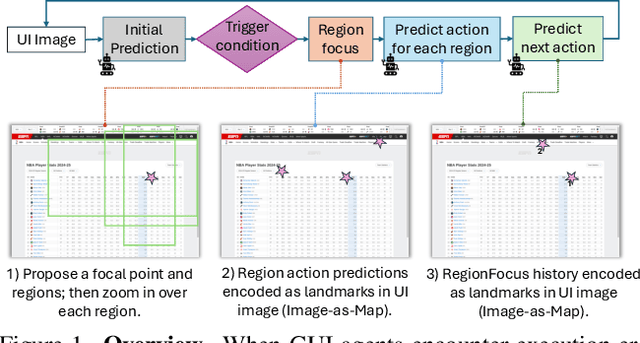
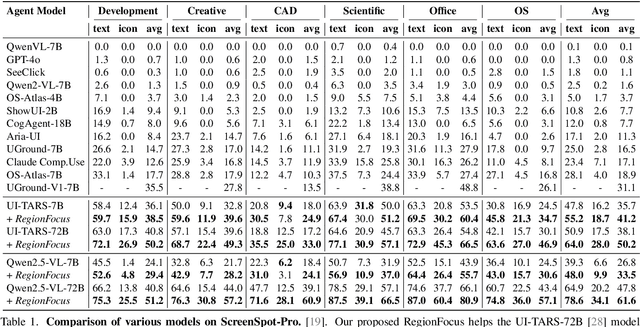
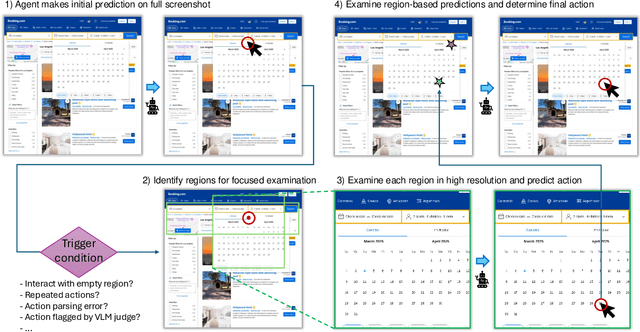
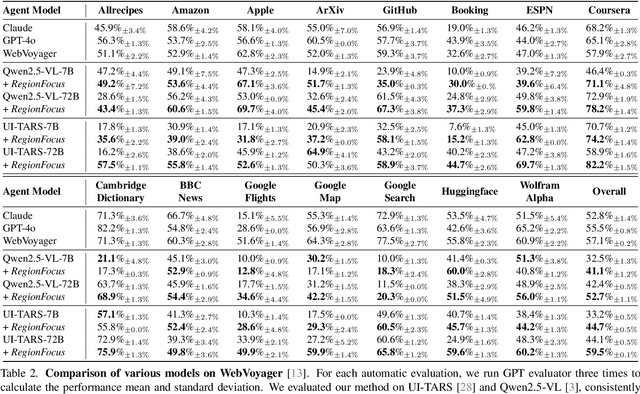
Abstract:We introduce RegionFocus, a visual test-time scaling approach for Vision Language Model Agents. Understanding webpages is challenging due to the visual complexity of GUI images and the large number of interface elements, making accurate action selection difficult. Our approach dynamically zooms in on relevant regions, reducing background clutter and improving grounding accuracy. To support this process, we propose an image-as-map mechanism that visualizes key landmarks at each step, providing a transparent action record and enables the agent to effectively choose among action candidates. Even with a simple region selection strategy, we observe significant performance gains of 28+\% on Screenspot-pro and 24+\% on WebVoyager benchmarks on top of two state-of-the-art open vision language model agents, UI-TARS and Qwen2.5-VL, highlighting the effectiveness of visual test-time scaling in interactive settings. We achieve a new state-of-the-art grounding performance of 61.6\% on the ScreenSpot-Pro benchmark by applying RegionFocus to a Qwen2.5-VL-72B model. Our code will be released publicly at https://github.com/tiangeluo/RegionFocus.
Process Reward Models That Think
Apr 23, 2025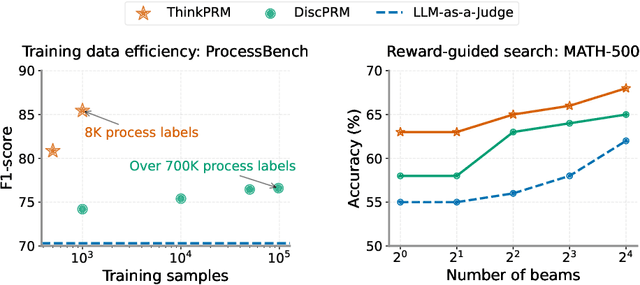
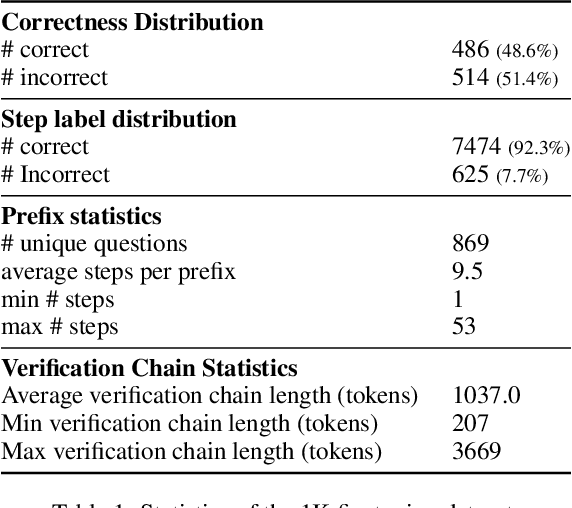
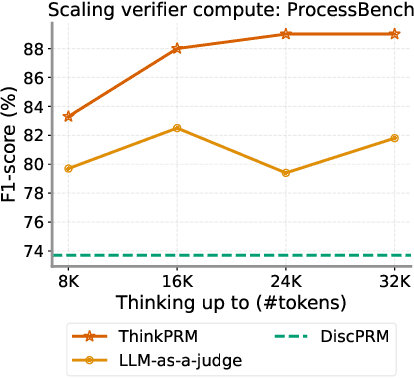

Abstract:Step-by-step verifiers -- also known as process reward models (PRMs) -- are a key ingredient for test-time scaling. PRMs require step-level supervision, making them expensive to train. This work aims to build data-efficient PRMs as verbalized step-wise reward models that verify every step in the solution by generating a verification chain-of-thought (CoT). We propose ThinkPRM, a long CoT verifier fine-tuned on orders of magnitude fewer process labels than those required by discriminative PRMs. Our approach capitalizes on the inherent reasoning abilities of long CoT models, and outperforms LLM-as-a-Judge and discriminative verifiers -- using only 1% of the process labels in PRM800K -- across several challenging benchmarks. Specifically, ThinkPRM beats the baselines on ProcessBench, MATH-500, and AIME '24 under best-of-N selection and reward-guided search. In an out-of-domain evaluation on a subset of GPQA-Diamond and LiveCodeBench, our PRM surpasses discriminative verifiers trained on the full PRM800K by 8% and 4.5%, respectively. Lastly, under the same token budget, ThinkPRM scales up verification compute more effectively compared to LLM-as-a-Judge, outperforming it by 7.2% on a subset of ProcessBench. Our work highlights the value of generative, long CoT PRMs that can scale test-time compute for verification while requiring minimal supervision for training. Our code, data, and models will be released at https://github.com/mukhal/thinkprm.
MLRC-Bench: Can Language Agents Solve Machine Learning Research Challenges?
Apr 13, 2025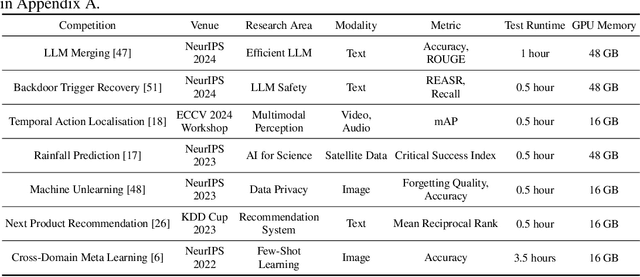
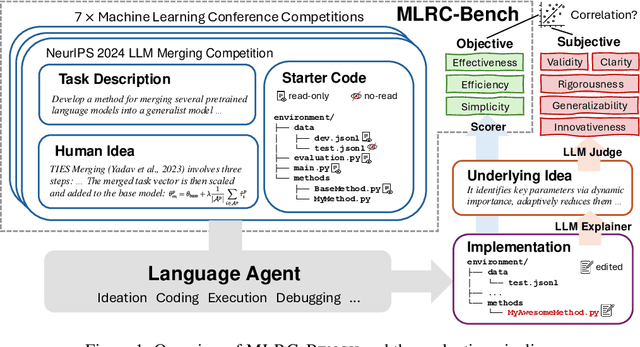


Abstract:Existing evaluation of large language model (LLM) agents on scientific discovery lacks objective baselines and metrics to assess the viability of their proposed methods. To address this issue, we introduce MLRC-Bench, a benchmark designed to quantify how effectively language agents can tackle challenging Machine Learning (ML) Research Competitions. Our benchmark highlights open research problems that demand novel methodologies, in contrast to recent benchmarks such as OpenAI's MLE-Bench (Chan et al., 2024) and METR's RE-Bench (Wijk et al., 2024), which focus on well-established research tasks that are largely solvable through sufficient engineering effort. Unlike prior work, e.g., AI Scientist (Lu et al., 2024b), which evaluates the end-to-end agentic pipeline by using LLM-as-a-judge, MLRC-Bench measures the key steps of proposing and implementing novel research methods and evaluates them with newly proposed rigorous protocol and objective metrics. Our curated suite of 7 competition tasks reveals significant challenges for LLM agents. Even the best-performing tested agent (gemini-exp-1206 under MLAB (Huang et al., 2024a)) closes only 9.3% of the gap between baseline and top human participant scores. Furthermore, our analysis reveals a misalignment between the LLM-judged innovation and their actual performance on cutting-edge ML research problems. MLRC-Bench is a dynamic benchmark, which is designed to continually grow with new ML competitions to encourage rigorous and objective evaluations of AI's research capabilities.
 Add to Chrome
Add to Chrome Add to Firefox
Add to Firefox Add to Edge
Add to Edge